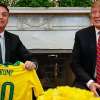Every June in Brooklyn a ritual unfolds that can shift the league’s balance of power with a single signature. In just a few hours, thirty front offices divvy up the planet’s best young basketball players, while fans speculate who will land the future superstar and who will pick the “dark horse.” To grasp the logic behind the glitzy ceremony, you need to know how the draft works, which rules underpin it, and why this knowledge helps not only team executives but also bettors hunting for value odds.
The Draft as a Reset Mechanism: Why the NBA Needs It
In European leagues powerful clubs buy ready-made talent for years, pulling away from rivals in budget and status. The NBA chose a different path: instead of an open rookie market it runs a centralized “call-up” system. The higher a team finishes in the regular season, the later it selects in the draft. This gives struggling franchises first access to top prospects and preserves parity.
For fans that means unpredictability: an apparent “outsider” can become a title contender within a couple of seasons if it hits the jackpot in the lottery. For bookmakers it is an endless puzzle, because lines must be re-balanced each time a new teenage phenom appears.
Who Can Declare: Automatic and Voluntary Paths
The road to the draft has two corridors:
- Automatic entry. Students who have played four full NCAA seasons, and international players who turn 22 by draft night.
- Voluntary application (Early Entry). Any player aged 19 or older—regardless of nationality—may file an official letter with the league office. NCAA freshmen can do so after their first year. The application may be withdrawn by the deadline and resubmitted the next year.
Remember: you cannot bypass the draft and join the league directly. Every rookie first belongs to the club that selects him and only then gains freedom of movement.
The NCAA: A Talent Forge Embedded in Education
The American sports model is tightly interwoven with the educational system. The front stage is the electric atmosphere of March Madness and the passionate emotions of campus crowds. Behind the scenes is robust infrastructure that provides young players with minutes, academic knowledge, and media exposure. Thanks to the NCAA, scouts have tons of statistics, and bettors have detailed numbers ranging from three-point percentage per possession to pick-and-roll efficiency.
Lottery Algorithm: Mathematical Fairness in Action
The first four picks are drawn among the 14 teams that miss the playoffs. Fourteen numbered balls go into the hopper, creating 1,000 valid combinations (one is reserved). The lower a team’s standing, the more combinations it receives.
Distribution of combinations:
- The three worst teams — 140 combos each (14 %).
- The fourth-worst team — 125 combos (12.5 %).
- The share falls to 0.5 % for the “strongest” lottery participant.
The process repeats until picks 1–4 are assigned. The remaining order follows regular-season records. The system is not perfect, but it keeps the league from turning into a cluster of dominant dynasties.
The Value of Picks and How GMs Trade Them
Draft picks are currency as valuable as cash. They are used to:
- Trade for stars when a team is ready to contend immediately.
- Accumulate during long-term rebuilds (“tanking”).
- Smooth complex deals, balancing disparities in player value.
Thus some franchises arrive at the ceremony with three or four selections, while others have none, having paid for past ambitions. To a bettor that signals a team stockpiling picks may explode soon, whereas a debt-ridden roster risks a lengthy slump.
Draft Day: Ceremony Script and Decision Timing
On the Barclays Center stage each team gets just five minutes for its first-round choice and two minutes in the second. The commissioner announces the selection, the player walks onstage, dons his new team’s cap, and poses for worldwide media. For young athletes it is the pinnacle of a childhood dream; for betting analysts it is the moment rumors solidify and roster strength can be recalculated.
Fates Without a Pick: The Free-Agent Chance
Missed out on the sacred 60 names? Your career is not over.
- As an undrafted free agent, you may sign with any team that offers a deal.
- Summer League and training camp serve as shop windows where a player can earn an Exhibit 10, a two-way contract, or a G-League invitation.
The stories of Fred VanVleet and Austin Reaves prove that those skipped on draft night can still earn minutes in the NBA. For betting markets this adds another layer of uncertainty—and opportunity for value seekers.
When a Player Objects: Rare but Loud Stories
The rule is clear: a player may appear only for the team holding his rights. Refusal effectively means a ban from the NBA. Yet disputes are settled diplomatically:
- The club signs the rookie and later looks for a trade to a more agreeable market.
- The player spends a season in Europe or the G-League, boosts his value, and returns via trade.
The sagas of J. R. Smith, Steve Francis, and the rumors around Cade Cunningham remind us that negotiation is part of the game. Bettors must track a rookie’s motivation; a disgruntled star prospect can underperform.
Betting Radar: How to Profit From the Rookie Season
Rookie of the Year (ROY) lines: books often overrate the top picks. Seek productive “surprises” with little media noise but heavy minutes.
Team totals: an incoming playmaker changes tempo, while an elite rim protector lowers opponents’ field-goal percentage. Reading the rookie’s impact early gives an edge before markets adjust.
Special markets: three-point records, double-doubles, and individual awards offer more room than standard outcomes.
The strategy is simple: watch Summer League, preseason, and coach statements. The sooner you understand a rookie’s role, the sooner you’ll spot an inflated price.
The draft is not just a TV show with suits and caps. It is a complex incentive system where a mathematical lottery meets human dreams, and general-manager decisions echo in the betting world even louder than on the court. By understanding the logic of pick distribution and the future paths of rookies, you gain an edge—whether you are an analyst, a fan, or a value-hunting bettor.





